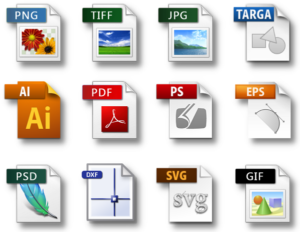 When it comes to professional printing, there are tons of acronyms and terms used to keep track of all the different file formats. People who might be involved in a printing project — yet don’t really know much about the terminology — often wonder about the difference between various file formats. Are there times where one of these file formats is preferable to the others — or even required?
When it comes to professional printing, there are tons of acronyms and terms used to keep track of all the different file formats. People who might be involved in a printing project — yet don’t really know much about the terminology — often wonder about the difference between various file formats. Are there times where one of these file formats is preferable to the others — or even required?
The short answer yes! Different file formats exist for the simple reason that some of these file formats are more suited to certain tasks than others. Depending on the type of graphic material you’re working with, and how you plan on archiving or manipulating that material prior to printing, you’ll be able to choose the best document format for your job. Keep reading to find out about the most common file formats for printing and when you should be using each one.
GIF (Graphics Interchange Format) File Format
The gif is one of the oldest file formats around. Partly for that reason, it is best suited to be used with simpler images and solid colors. If you are printing logos or other graphics with solid block coloring, the gif file format is a good bet. A great perk of GIF files is that the allow for transparent backgrounds increasing the versatility of images that can be created. That said, GIF files don’t provide quality suitable for images with continuous color such as photographs.
JPEG (Joint Photographic Experts Group) File Format
After GIF, JPEG came along and soon became one of the most popular file formats to use with graphics. JPEG formatting will provide you the high quality you are looking for when printing images with continuous color such as photos or drawings with color gradients. JPEG files are very small which creates some limitations in the types and size of images that can be saved in this format. Additionally, there is some loss of quality when JPEG images are saved.
EPS (Encapsulated PostScript) File Format
EPS file format is best for printing high-resolution images and illustrations from programs such as Adobe Illustrator. EPS files are vector images meaning that they can be resized and scaled without degradation of quality. This makes EPS files a great option for images or logos that will need to be printed in a variety of sizes.
PNG (Portable Network Graphics) File Format
The PNG file type is one of the newest file formats available for images. PNG files combine the best of both worlds when it comes to printing solid color images or those with continuous color. These files won’t degrade in quality when archived or shared, and provide high quality color and resolution regardless of the simplicity or complexity of the material you are printing.
Which file format should I use?
Keep in mind that professional printers usually have a list of specifications beyond just the file type. In other words, JPEG and PNG and PDF (and pretty much every other type of file) can be saved and exported with different variables. Preparing your files for professional printing will often involved following specific directions from your printer.
When it comes to choosing a direct mail specialist, you may want ask up front what types of file formats would be required for your project. You want to make sure that you’re getting the highest quality printing for the types of graphic material you’ll be working with. It’s always a good idea to ask to see product samples to see the quality of work they’ve done in the past before making a commitment.


